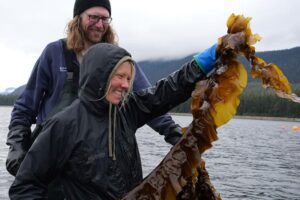
NOAA Fisheries has released its Alaska 2023 Aquaculture Accomplishments Report, highlighting 14 projects that supported the Alaska aquaculture priorities of managing sustainably and efficiently, leading science for sustainability and educating and exchange of information.
For 2023, NOAA’s Alaska Aquaculture Program prioritized 10 of 17 total national objectives listed in the 2023-2028 Aquaculture Strategic Plan.
One highlight of the year is a project underway at the Alaska Fisheries Science Center’s (AFSC) Kodiak Lab, a collaboration with local kelp farmers to investigate how farmed seaweed compares to natural seaweed beds as a habitat for local marine animal species.
Fishery ecologist Alix Laferriere is using video surveys, Standard Monitoring United for the Recruitment of Fish (SMURFs), and environmental DNA to compare the diversity and abundance of species living in farmed seaweed beds to those of natural beds to determine the extent to which seaweed aquaculture provides habitat for Alaska species.
Another highlight is an oyster selective breeding program established at the Alaska Fisheries Science Center’s Auke Bay Laboratories at the Ted Stevens Marine Research Institute in Juneau. That project is intended to address the Alaska oyster industry’s current reliance on oyster seed spawned outside of Alaska and resulting shortage of hatchery seed supply and insecurity for oyster farmers.
NOAA researchers have begun building a hatchery to house, condition and spawn oyster broodstock and subsequent generations.
In June, NOAA announced that Alaska would be the next region to begin the Aquaculture Opportunity Area (AOA) identification process. This multi-year process, led by regional aquaculture coordinator Alicia Bishop, includes a collaboration of the NOAA Fisheries Alaska Regional Office and the National Centers for Coastal and Ocean Science to produce a portfolio of marine spatial analysis data for aquaculture development in Alaska.
Data collected during the AOA process from stakeholders, the public, tribal communities, state and federal agencies and other organizations will be used to lay the groundwork for future site suitability analysis and development of atlases as part of the Alaska AOA identification process.
